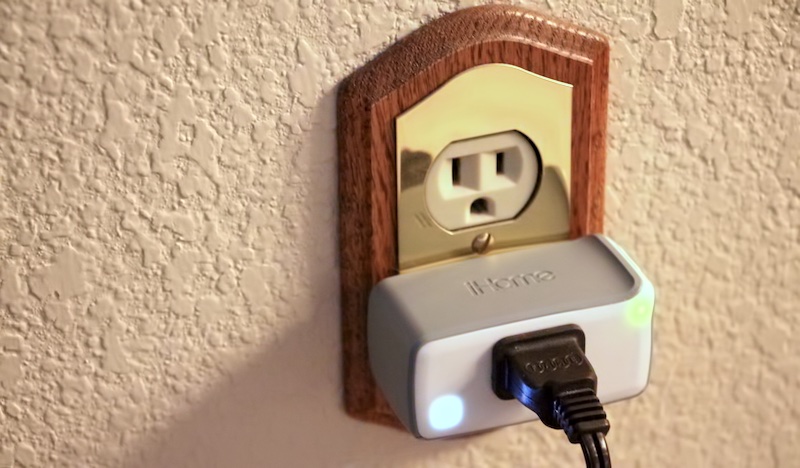
The iHome iSP5 Smart Plug (US$39.99) represents a first for Apple World Today; the first HomeKit-compatible hardware we’ve had the pleasure to review. Up to this time, all the smart plugs and intelligent light bulbs reviewed here or at The Unofficial Apple Weblog did not include HomeKit capabilities. In this review I’ll talk about what that means for those who’d like to automate their homes, and why the iSP5 is a welcome move to the future.
Design
The iSP5 is an attractive and very compact smart plug. Unlike some of the first plugs that came out a few years ago, the iSP5 is only about 1.25″ deep x 1.5″ high X 3″ wide. It’s a passthrough plug, meaning that you plug it into an available 120V US wall socket and then plug a lamp or small appliance into it. One one side of the iSP5 is a raised bump that serves as a push switch should you need to turn a light on or off without a smartphone or tablet. To reset the iSP5 to factory defaults, that button is held down for 12 seconds at which point an LED flashes red/green. Releasing the button displays a flashing green LED, and when the device is properly set up it goes to solid green.

There’s no need for a hub with this system; instead, each smart plug or device becomes a separate controllable entity on the network. All of the control and setup is done through the iHome Control app, which is the first app I’ve used that complies to Apple’s HomeKit standards. The app has a very clean user interface in shades of blue and green, and provides a way to identify a hierarchy of locations and devices: Homes (if you have more than one), Rooms (bedroom, kitchen, study, etc…), Zones (bedroom, kitchen and study could be an “inside” zone, for example), and devices.
The app also provides a way to set up scenes — for example, you might want to have certain lighting and music settings for a party or for watching movies — and rules. Let’s say that I want a bedroom lamp to turn on automatically every Sunday through Friday night at 9 PM. I can set up a rule to do that — the light will turn on, I will then use the app or Siri to turn it off later.
Function
Setup of the plug is a piece of cake. I plugged it in, did a reset using the process described above, and then tapped “Add Device” in the app. The switch, which was identified with a factory defined name, was quickly located and added to my list, and I was able to rename the switch as “Bedroom Light”. Details can be added to the devices, like the home that it resides in, the room, the time zone, and any rules associated with the switch.
By the way, you’ll be prompted to enter a HomeKit Accessory Setup Code at one point. It’s an 8-digit code that makes it possible for you to use Siri to control the switch.
The app provides immediate feedback that a connected accessory — in this case the iSP5 — is on or off by changing the button color from grey to green. And it’s also lightning-fast! I’ve often seen a delay with other smart plugs when I turn a light on or off. That’s not the case with the iSP5; the second I tap a button the light is on.
But it’s the Siri functionality that I most wanted to try out, and I can say that it works very well. In the past, I used a bunch of kludgy workarounds, most of which required me to send a message to a specific IFTTT address, then have it turn on a switch upon voice command. Now all I need to do is tell Siri “Turn on the bedroom light” and it’s done.
Somewhere else in your house and you want to know if a light is on? Just ask Siri — “Is the bedroom light on?” and it lets you know if that light is on or off. I even asked it to turn on all the devices at my address, and it knew what I meant. However, telling Siri to turn off all the devices at my address didn’t work, so there’s a bit of work to be done somewhere.
Although I commented earlier about IFTTT being a kludgy solution for Siri control of smart devices, I do wish that iHome would consider giving the iSP5 an IFTTT channel for other automation integration. For example, being able to have the Elgato Eve Room Sensor (another HomeKit device) or Weather Sensor turn on an iSP5 under specific conditions would be great.
Only one other minor complaint: with the WeMo switch, it’s possible to turn off the LED that shows that the switch is connected to the network. With the iSP5, that LED cannot be shut off, so there’s always a green “night light” glowing in your room…
At $39.99, the iSP5 is $20 less expensive than the Belkin WeMo Insight Switch (which also provides data on energy usage) and $15 less than the generic Belkin WeMo Switch. iHome is aggressively pricing the iSP5, which is a very positive sign.
Conclusion
The iHome iSP5 is less expensive than its competitors, smaller and more attractively designed than most, and doesn’t require the use of an expensive hub. Setup is easy, and the ability to control a light from Siri is almost magical. The inability at this time to integrate with other HomeKit devices is a bit of a concern, although the product — and HomeKit in general — is still in its infancy.
Apple World Today Rating (out of 5 stars): ★★★★
Plan on buying one or more of these Smart Plugs now that you’ve read the review? Be sure to buy through Amazon and help support Apple World Today.
